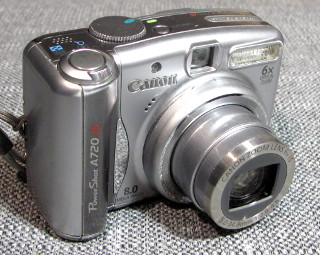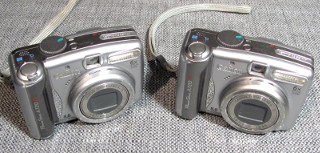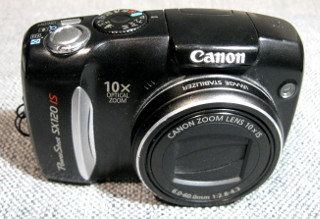<HOME
<Hiking
<Photography
Canon PowerShot A720 IS
That's one tough camera for hiking!
 I like taking pictures, but I mostly use a bulky
DSLR for that (a Canon EOS 1Ds Mark-II primarily). I also like
hiking in Lapland, often
for extended periods up to six weeks, and my
backpack is heavy... So in 2010 I bought a
used Canon PowerShot A720 IS to take photos when hiking.
Oh boy, did I get my money's worth! When
choosing this camera, my criteria were:
I like taking pictures, but I mostly use a bulky
DSLR for that (a Canon EOS 1Ds Mark-II primarily). I also like
hiking in Lapland, often
for extended periods up to six weeks, and my
backpack is heavy... So in 2010 I bought a
used Canon PowerShot A720 IS to take photos when hiking.
Oh boy, did I get my money's worth! When
choosing this camera, my criteria were:
- it uses AA batteries!!! This was an absolute must!
- it supports CHDK
(though ultimately I never did find much use for that)
- it is relatively small and lightweight (no, I don't want an
almost-DSLR like the PowerShot S5 IS, with most of the
bulk but none of the benefits of an actual DSLR)
- it has reasonable manual control features (even without CHDK)
Why AA batteries? Because I mostly do not use this
point-and-shoot camera for anything else—only hiking,
once or twice a year. Such infrequent use is really bad for the
well-being of proprietary lithium battery packs, but on the rare occasions
when I do use the camera, I need several spare batteries as well
(because I use it for several weeks without a chance to recharge).
Low self-discharge NiMH AA cells are what fits the bill—they're
cheap, well behaved, and find loads of other use as well. I have found
Sanyo/Panasonic 2000 mAh Eneloops to be very good for all
purposes. I have no experience of higher-capacity later-generation Eneloops,
because these old ones just refuse to
die! :)
(I recently found four Eneloops, over 12 years old, unused for
perhaps the last 2 years, which I charged up and cycled once in my
battery charger/analyzer, and they still read about 1900 mAh. I
stuck them in a monster Canon 540EZ camera flash, and was not surprised
when it did not start up... But then I noticed two of the batteries had
actually rusted terminals! One too many damp hikes, then? I polished
them with fine sandpaper, applied some contact spray, and tried
again—and now the flash cycled over and over and over again, as
long as I cared to go on testing, and as fast as with brand new NiMH
cells!)
The A720 IS was introduced around 2007, so it's definitely not
a hot new product. It has "only" 8.0 megapixels and a
"modest"
6× optical zoom, and the sensor goes to "just"
ISO 1600, with ISO 400 being all-around usable. But it does have
lens-shift image stabilization and good manual adjustments i.e. it
has P, Tv, Av and M modes,
+/− 2 EV
exposure compensation in 1/3 stop increments, flash with fully manual
control (though not very fine-grained) and even 2nd curtain sync.
Still, it's not trying to be a professional camera, or an especially rugged
one either—it's just a plain, plasticky point-and-shoot. But man,
oh man, has it ever stood up to use!
It has survived my
2010,
2012,
2013,
2014,
2015,
2017,
2018,
2019,
2020,
2022,
2023 and
2024
summer hikes, totaling some
39 weeks out there in the wild, plus several shorter
excursions, including some in winter. This camera has been through
hell, as far as cheap plasticky consumer electronics are
concerned! Along the way it has seen all kinds of
use and abuse, absolutely stupid weather, rain, and dampness in general
for prolonged periods—things I would never have
expected any compact camera to take! In fact, light snowfall killed
the battery grip on my EOS 5D DSLR before I obtained my
A720 IS! So this is one tough, tough camera!!!

|
It was so tough, and such a good performer overall, that when I saw
another A720 IS on an online auction site in 2020, I grabbed
it as well. At that point, the model was 13 years old, but still fit the
bill for my use just fine! (And I got it really cheap, can you
believe?) So now I have a spare, in case the first one ever does break.
Or rather, I have two spares, because...
|
Canon PowerShot SX120 IS

|
...soon after picking up the second A720 IS, I found a used
PowerShot SX120 IS in good condition, and it's now a contender
to take over from the venerable A720 IS. It was introduced
in 2009 (so it's all of two years newer technology), has a whopping
10 Mpix and a 10× zoom, but is otherwise very similar
(i.e. it's a plasticky compact, has lens-shift image stabilization,
and the ISO range ends at 1600, ISO400 still being quite usable). Its looks
are not quite as retro, though. But let's see if it can handle the
elements as well as the A720 IS! For my money, the
A720 IS is the king of bad weather conditions!
I may have slightly overpaid for the SX120 IS, but no
matter. And I wouldn't mind at all paying up for a brand new aluminum-body
(or is it magnesium that's all the rage right now) compact camera, one
with a more modern image sensor,
if only I could find one that takes AA batteries! But I honestly
haven't put much effort into finding one, as even the plastic
A720 IS just refuses to die... :)
*** UPDATE! *** No, this camera does
not handle the elements
nearly as well as the A720 IS! I took this camera with me on
my 2021 hike,
and after one single day of rain, the display fogged up
on the inside, and the image stabilizer went berserk, rumbling like crazy
even when deactivated! Everything did get back to normal after a day of
drying in the sunshine and wind, but this camera obviously cannot hack bad
weather! Don't get me wrong, this is otherwise a fine camera (I would
otherwise prefer this to the A720 IS), and this lack
of waterproofness is what I'd expect from a cheap plastic toy camera
like this. It just goes to show, how awesome the A720 IS
is in that respect! On my
2022 hike I reverted back to my
original A720 IS.
|
Battery issues
Not that the A720 IS is perfect, mind you. Like many
PowerShots, it does have a tendency to complain of depleted
batteries, even when they are freshly charged, as your favorite search
engine can confirm. The "toothpick fix" did nothing for my
camera. I know there are instances where the solder joints of the battery
contacts to the main circuit board have broken, causing these symptoms.
But in my own experience, this problem mostly happens:
- when the batteries are fully charged, just out of the charger.
That's when their voltage changes the fastest, as it falls from
the "fully charged" voltage of around 1.5 V/cell to the
"nominal" voltage of 1.2 V/cell. It seems the camera
mistakes this rapid voltage change for alkalines that are about to die.
Just ignore the warning and keep using the batteries—if the camera
demands you change them, just open and close the battery compartment
lid and try again. Once the voltage settles at 1.2 V/cell, the camera
will stop pestering you about it. Then it will just work for hundreds
of shots without complaint.
- when the batteries are, in fact, depleted or otherwise worn out
(well, doh).
If you have been using them for a couple hundred shots, maybe it
is time to recharge them. Also, a digital camera does consume
significant instantaneous current, and NiMH cells don't last
forever. If they've been recharged hundreds of times already, maybe
they've already done their job. Also check whether their terminals
are corroded—the A720 IS handles dampness just fine,
but the batteries may actually start to rust!
- when the coin cell backup battery is worn out!!! This
is weird—when the CR1220 battery (which maintains the camera's
real-time clock and settings) is running low, that somehow causes the
camera to complain its main batteries are running down!
Replacing the backup
battery immediately solved the problem for me! So when new, fully
charged NiMH batteries give you grief all the time, try replacing
the coin cell first! (I'm glad I did, before disassembling the camera
to resolder joints and/or to replace the electrolytics in its SMPS.)
I don't know whether similar issues crop up with the SX120 IS.
I doubt I'll be using that camera enough to find out, because of its
aversion to rain.
Antti J. Niskanen <uuki@iki.fi>
 I like taking pictures, but I mostly use a bulky
DSLR for that (a Canon EOS 1Ds Mark-II primarily). I also like
hiking in Lapland, often
for extended periods up to six weeks, and my
backpack is heavy... So in 2010 I bought a
used Canon PowerShot A720 IS to take photos when hiking.
Oh boy, did I get my money's worth! When
choosing this camera, my criteria were:
I like taking pictures, but I mostly use a bulky
DSLR for that (a Canon EOS 1Ds Mark-II primarily). I also like
hiking in Lapland, often
for extended periods up to six weeks, and my
backpack is heavy... So in 2010 I bought a
used Canon PowerShot A720 IS to take photos when hiking.
Oh boy, did I get my money's worth! When
choosing this camera, my criteria were:

